The Ultimate Facebook Ads Targeting Tutorial in 2023
Last updated: Jul 30, 2023
This video is a tutorial on how to effectively target Facebook ads, including location targeting and the importance of advertising to the right audience.
This video by Ben Heath was published on Aug 8, 2023.
Video length: 56:45.
This YouTube video titled "The Ultimate Facebook Ads Targeting Tutorial in 2023" is a tutorial on how to effectively use Facebook ads targeting options.
The video explains the importance of targeting specific audiences and walks viewers through the process of setting up targeting options in Facebook Ads Manager. The tutorial covers location targeting and advises against unnecessarily restricting geographical targeting. It also mentions the importance of considering business goals when selecting target locations.
The video provides examples and recommendations for targeting strategies based on different types of businesses and campaign objectives.
- This video is a tutorial on how to effectively target Facebook ads.
- The tutorial covers location targeting and the importance of advertising to the right audience.
- The information applies to all types of campaigns, but the focus is on leads campaigns.
- Go to the ad set level in Facebook Ads Manager.
- Scroll down to the targeting section.
- Start with location targeting and choose the specific locations you want to target.
- Consider advertising in places where people are likely to buy your products or services.
- After location targeting, consider demographic targeting.
- Choose the age range, gender, and language of your target audience.
- Utilize custom audiences to target people who have already interacted with your business.
The Ultimate Facebook Ads Targeting Tutorial in 2023 - YouTube

Introduction
- This video is a tutorial on how to effectively target Facebook ads.
- The tutorial covers location targeting and the importance of advertising to the right audience.
- The information applies to all types of campaigns, but the focus is on leads campaigns.

Setting Up Targeting
- Go to the ad set level in Facebook Ads Manager.
- Scroll down to the targeting section.
- Start with location targeting and choose the specific locations you want to target.
- Consider advertising in places where people are likely to buy your products or services.
- Don't unnecessarily restrict your geographical targeting based on assumptions about your best prospects.

Demographic Targeting
- After location targeting, consider demographic targeting.
- Choose the age range, gender, and language of your target audience.
- Consider the demographics of your ideal customers and tailor your targeting accordingly.
- Use Facebook's detailed targeting options to narrow down your audience based on interests, behaviors, and connections.
- Experiment with different combinations of targeting options to find the most effective audience for your ads.

The Ultimate Facebook Ads Targeting Tutorial in 2023 - YouTube
Custom Audiences and Lookalike Audiences
- Utilize custom audiences to target people who have already interacted with your business.
- Create custom audiences based on website visitors, email subscribers, or app users.
- Create lookalike audiences to reach people who are similar to your existing customers.
- Use the Facebook pixel to track website visitors and create custom audiences based on their actions.
- Experiment with different custom audiences and lookalike audiences to find the most responsive audience for your ads.

Setting up Location Targeting
- Set the location targeting first when creating Facebook ads.
- Consider whether your business serves a specific location or the entire country.
- Look at the estimated audience size on the right-hand side to determine the reach of your ads.
- For local businesses, the audience size will be smaller, so targeting options may need to be broader.
- For international campaigns, the audience size can be larger, allowing for more specific targeting.

Determining Age Range
- Be generous when selecting the age range for your target audience.
- Consider the typical age range of your customers, but also include a broader range to capture potential customers outside of the average.
- Leaving the age range open can still be effective due to Facebook's machine learning process.
- If in doubt, go with a broader age range to reach a wider audience.
- Adjust the age range based on your specific customer demographics.

Gender Targeting
- Unless your audience heavily skews towards one gender, it's recommended to target all genders.
- Facebook's machine learning process can determine the gender preferences of your target audience based on their behavior and interests.
- Consider the occasions when people of different genders may purchase your product or service.
- For example, if you sell women's jewelry, men may also buy it for special occasions like Christmas or Valentine's Day.
- Adjust the gender targeting based on your specific product or service.

Detailed Targeting
- There are no secret hidden audiences in Facebook advertising.
- Choose interest targeting options that sound logical and relevant to your business.
- Search for terms closely related to your business to find relevant targeting options.
- Avoid making mistakes with interest targeting by selecting options that make sense for your audience.
- Experiment with different interest targeting options to find the best ones for your ads.

Targeting Options
- When targeting Facebook ads, it's important to focus on people who are interested in your business rather than specific job titles.
- For example, if you're in the social media marketing space, target people interested in social media marketing or digital marketing instead of specific job titles like digital marketing strategist.
- Use the suggestions option to find closely related interests to your business and create a list of 10-15 relevant options.
- For a dog walking business, target people interested in dogs, dog walking, and dog grooming.
- Test different targeting options to see which ones produce the best results for your business.

Advantage Detail Targeting
- Advantage Detail targeting is a setting that allows Facebook to advertise to people who may not be included in your selected interest category.
- During the testing phase, it's recommended to turn off Advantage Detail targeting and focus on advertising to people specifically interested in your business.
- Meta's machine learning and AI algorithms are improving, so leaving Advantage Detail targeting on is not a big mistake.
- Estimated audience size is important, and it's usually better to have a larger audience size unless you have a specific reason to target a smaller audience.
- You can also specify languages if you want to target a specific language-speaking audience.
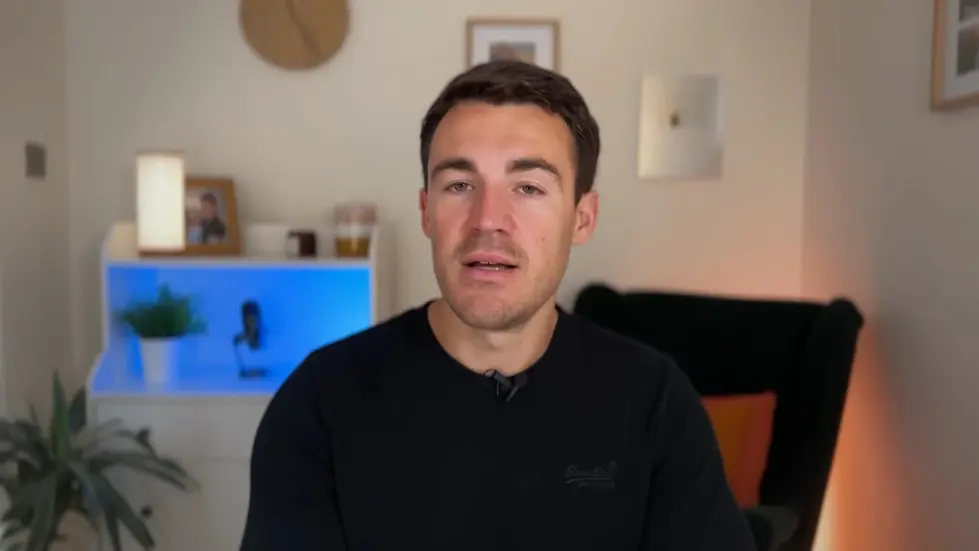
Location, Demographic, and Interest Targeting
- Location, demographic, and interest targeting are the basic targeting options for Facebook ads.
- Create a list of 10-15 different interest targeting options that are relevant to your business.
- Test different ad sets with different targeting options to see which ones perform the best.
- Make sure not to target a too small or specific audience, as it limits Facebook's flexibility and may not reach enough people.
- Give Facebook more freedom and flexibility in targeting to maximize reach and potential customers.

Advanced Targeting Options
- There are more advanced targeting options that can be used, but they are not covered in this video.
- These advanced options are typically used by agencies and require more expertise.
- If you're interested in these advanced options, consider using a done-for-you Facebook and Instagram advertising service.
- These services can create, manage, and optimize your campaigns to get the best possible results.
- Book a free call with a team member to learn more about these services.

Custom Audiences
- Custom audiences allow you to reach people who have already interacted with your business.
- Retargeting ads to warm audiences, such as website visitors or email subscribers, can produce better results than advertising to cold audiences.
- To create custom audiences, go to Ads Manager, click on "All Tools," then "Audiences."
- The two sources of custom audiences are "Your Sources" (people who have interacted with your business outside of Facebook) and "Meta Sources" (actions taken within the Facebook family of apps).
- One common custom audience option is "Website," which allows you to target people who have visited specific pages on your website.
- You can also create custom audiences based on specific actions, such as signing up for a webinar but not purchasing a course.
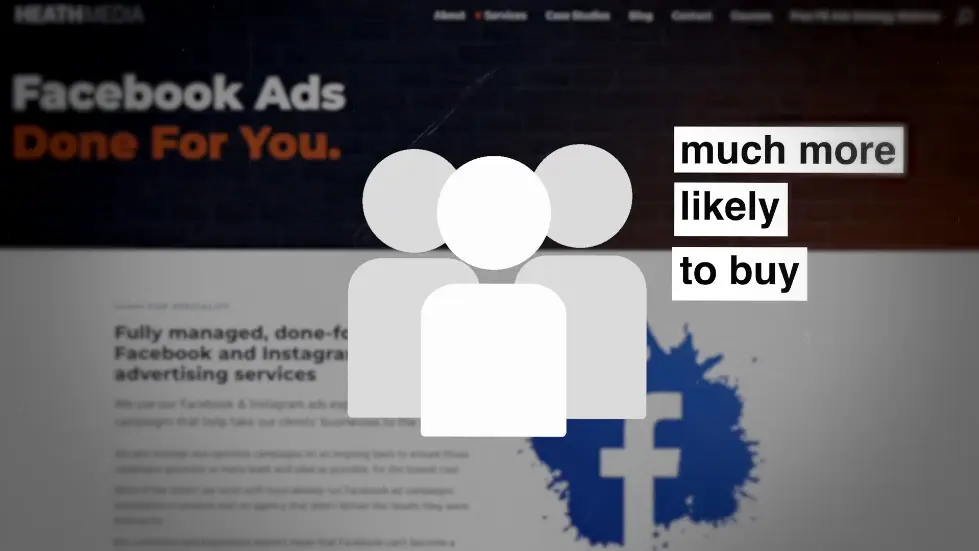
Lookalike Audiences
- Lookalike audiences are similar to your custom audiences and can help you reach new people who are likely to be interested in your business.
- To create a lookalike audience, select a custom audience as a source and choose the location and audience size.
- Lookalike audiences can be created based on website visitors, email subscribers, or other custom audiences.
- Experiment with different audience sizes to find the right balance between reach and relevance.
- Lookalike audiences can be used in conjunction with other targeting options, such as interests or demographics.

Interest Targeting
- Interest targeting allows you to reach people based on their interests, hobbies, and activities.
- You can target broad interests or narrow down to specific interests within a category.
- Facebook provides suggestions for popular interests, or you can search for specific interests.
- Combine interest targeting with other targeting options, such as demographics or behaviors, to refine your audience.
- Monitor the performance of your interest targeting and make adjustments based on the results.
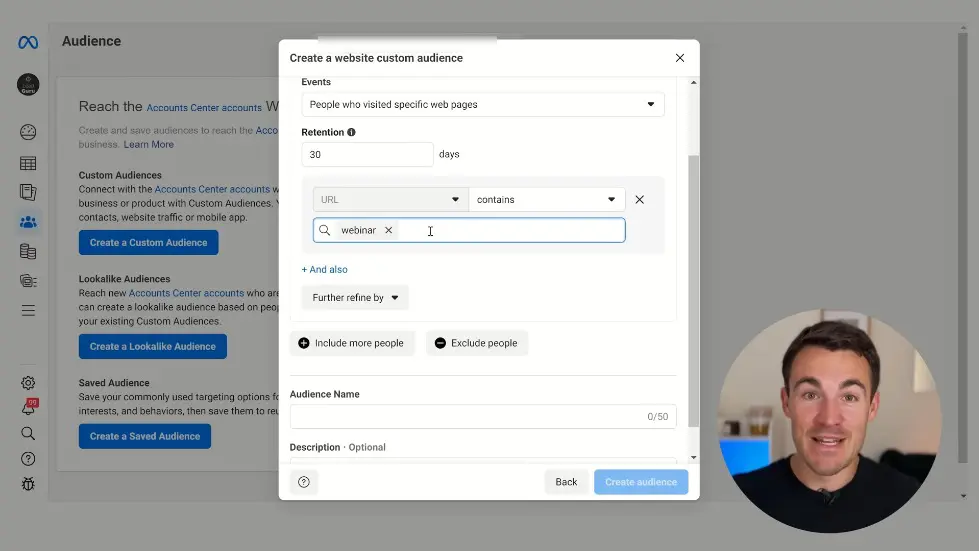
Location Targeting
- Location targeting allows you to reach people in specific geographic locations.
- You can target countries, regions, cities, or even specific addresses.
- Use location targeting to reach people in areas where your business operates or where you want to expand.
- Consider using radius targeting to reach people within a certain distance from a specific location.
- Exclude locations where your business is not relevant or where you don't want your ads to appear.

Website Custom Audiences
- Create a custom audience of people who have visited specific web pages on your website.
- Exclude people who have already made a purchase by excluding URLs with "thank you" pages.
- You can further refine and exclude people to create different layers of custom audiences.
- Target people based on the amount of time they have spent on your website.
- Retention window affects the size and warmth of the custom audience.

Events Custom Audiences
- Create a custom audience based on specific events, such as adding items to cart or initiating checkout.
- You can target people who have added items to cart but haven't made a purchase yet.
- Exclude people who have triggered the purchase conversion event.
- Use retention window to determine the warmth of the audience.
- Meta algorithms prioritize warmer prospects before targeting less warm prospects.

All Website Visitors
- Target all website visitors within a specific retention window, such as 30 days or 180 days.
- Meta algorithms prioritize warmer prospects before targeting less warm prospects.
- Give your custom audience a name that is easily recognizable.
- You can create multiple types of website visitor custom audiences based on different criteria.
- Use naming conventions to easily identify and manage your custom audiences.

Customer List Custom Audiences
- Create a custom audience based on a list of customer email addresses or phone numbers.
- Upload a CSV or TXT file containing the customer information.
- Facebook will match the uploaded information with existing Facebook users.
- You can use customer list custom audiences for retargeting or exclusion purposes.
- Ensure that the customer information is accurate and up to date.

Uploading Customer and Email Lists
- You can upload two types of custom audiences: customer lists and email lists.
- If you use MailChimp, you can easily import your list from there.
- If you use a different email service or CRM, you can export your list as an Excel or CSV file and upload it.
- When uploading a customer list, you can indicate if you have a value column that shows how much each person has spent with you.
- You can give your list a name and map the information in your CSV file to the appropriate fields in Meta.
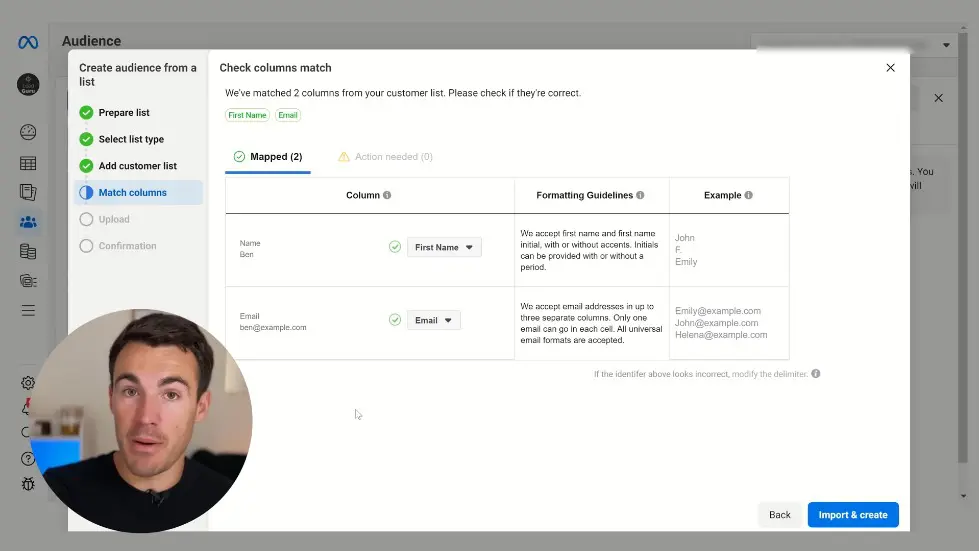
Matching Data to Facebook and Instagram Profiles
- Meta matches the information in your list to people's Facebook and Instagram profiles.
- The match rate is typically around 50%, so not everyone on your list will be matched.
- The more information you have in your list, the higher the chances of a successful match.
- It's recommended to include as much information as possible when uploading customer or email lists.
- Once you've mapped the information, you can import and create your custom audience.
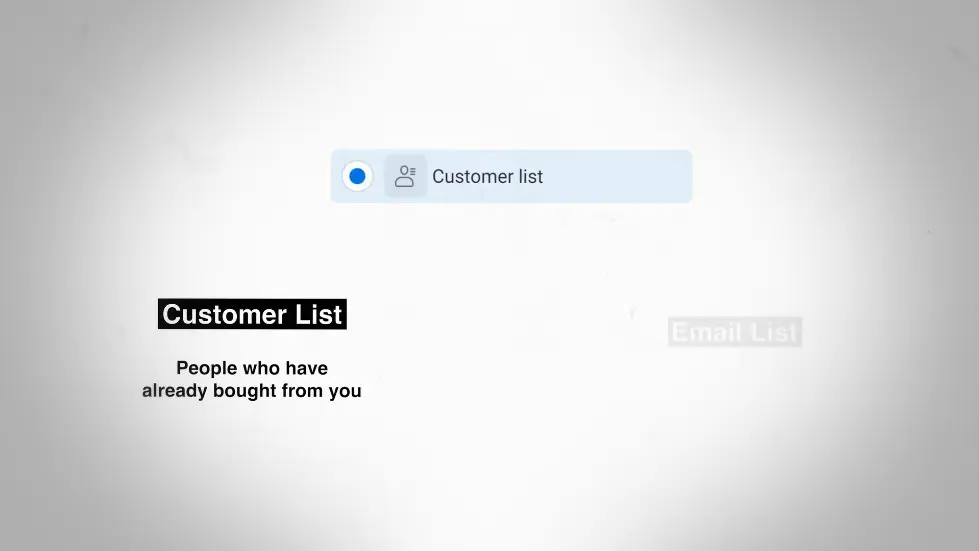
Creating Separate Email and Customer Lists
- It's best to create separate email and customer lists.
- This allows you to target people who haven't bought from you previously, as well as those who have.
- There may be times when you only want to advertise to previous customers or times when you want to target both.
- Advertising to previous customers can serve as a reminder and encourage repeat purchases.
- Don't underestimate the value of retargeting previous customers.

Custom Audiences
- There are different custom audience options, including website and customer list.
- Using the catalog option is beneficial for e-commerce businesses.
- Video and app activity are other options for custom audiences.
- Website and customer list are commonly used by businesses.
- Choosing the right custom audience depends on the specific needs of the business.

Meta Sources
- Meta sources, such as video, provide more accurate tracking data.
- Meta sources have a lower barrier to entry compared to other custom audience options.
- Video views on Facebook and Instagram can create larger custom audiences.
- Choosing the amount of video someone needs to watch depends on the desired audience size.
- Options include three seconds, 25%, or through play for longer videos.
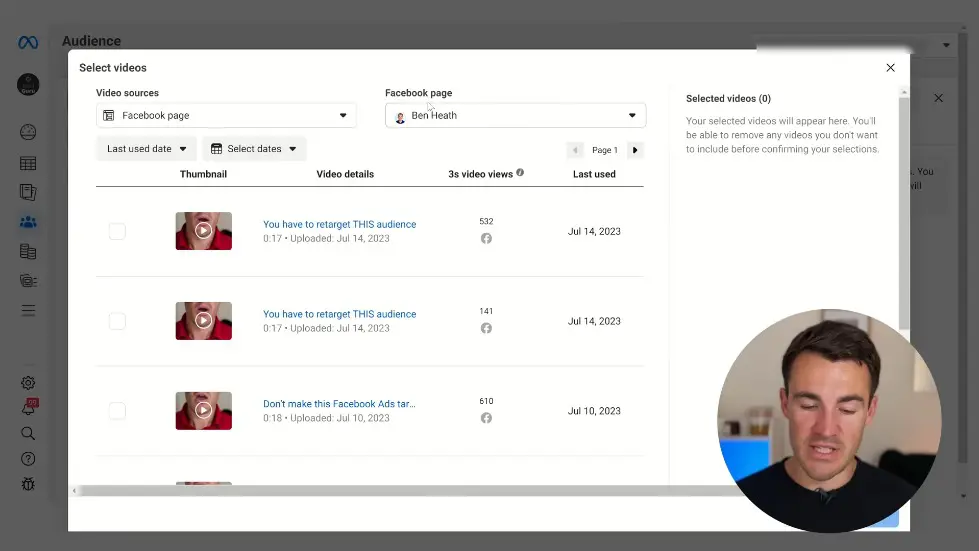
Choosing Videos for Custom Audiences
- Selecting videos from the right Facebook page is important.
- Multiple videos can be selected to create custom audiences.
- Specific campaigns and Instagram profiles can also be used to create custom audiences.
- Retention can be set for a specific period, with 365 days being the default.
- Adding a specific category or description can help with organization.
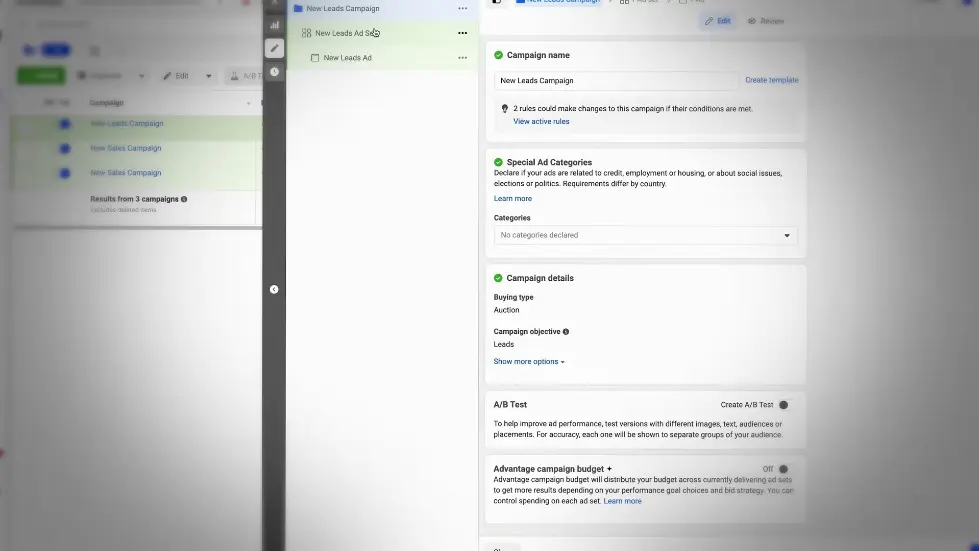
Lead Form Custom Audience
- Lead form custom audience is an option for advertisers using instant forms.
- Instant forms are presented to users instead of taking them to a website or landing page.
- Not all advertisers will be able to use this option.
- Lead forms are becoming popular among advertisers.
- There are videos available for more information on lead forms.

Creating Custom Audiences from Lead Forms
- You can create custom audiences from people who have engaged with your lead forms.
- You can retarget people who opened but didn't submit the form to encourage them to complete it.
- You can retarget people who opened and submitted the form with a video testimonial to convince them to convert.
- It is recommended to go with anyone who opened the form to get them to submit it.
- Select the lead forms by name and set the retention period.
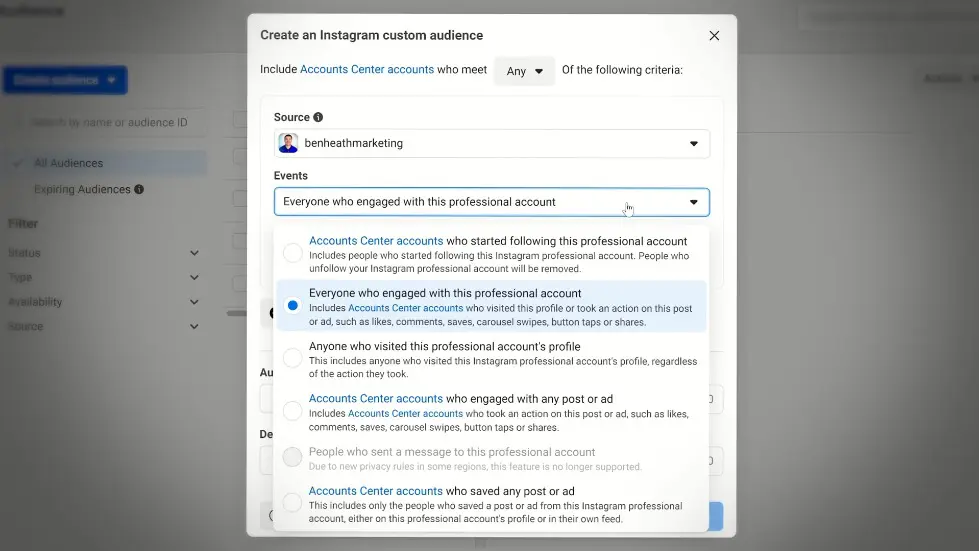
Creating Custom Audiences from Instagram Account
- You can create a custom audience of anyone who has engaged with your Instagram account.
- Options include anyone who started following, visited your profile, or engaged with a post or ad.
- It is recommended to go with everyone for maximum reach.
- Set the retention period to 365 days.
- This audience can be large and useful for retargeting.
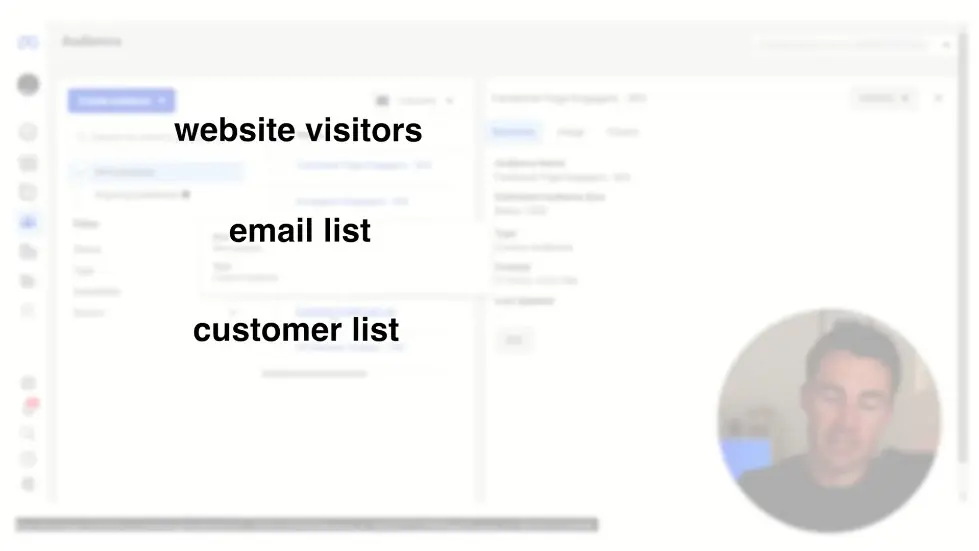
Creating Custom Audiences from Facebook Page
- You can create a custom audience of people who have engaged with your Facebook page.
- Options include people who follow your page or have engaged with it in various ways.
- It is recommended to go with everyone for maximum reach.
- Set the retention period to 365 days.
- Give the audience a name and click create audience.

Using Custom Audiences in Ads Manager
- In Ads Manager, go to the ad set level and scroll down to the custom audience section.
- Add the custom audiences you want to retarget.
- It is recommended to have a separate retargeting ad set or campaign for your custom audiences.
- Mixing and matching cold audience targeting with retargeting doesn't work well.
- Having a separate retargeting ad set allows for better control and optimization of your ads.
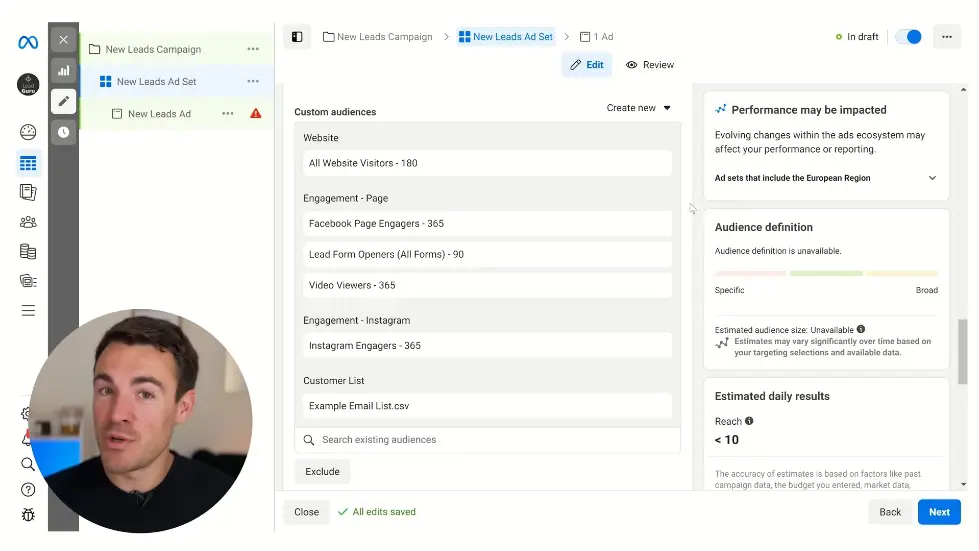
Importance of Bundling Retargeting Audiences
- Bundle all retargeting audiences together in one ad set.
- Warm audiences produce better results from a return on investment standpoint.
- Warm audiences are smaller than cold audiences.
- Separate different interests into different ad sets for cold audiences, but not necessary for warm audiences.
- Spending as much as possible on warm audiences without bombarding them.
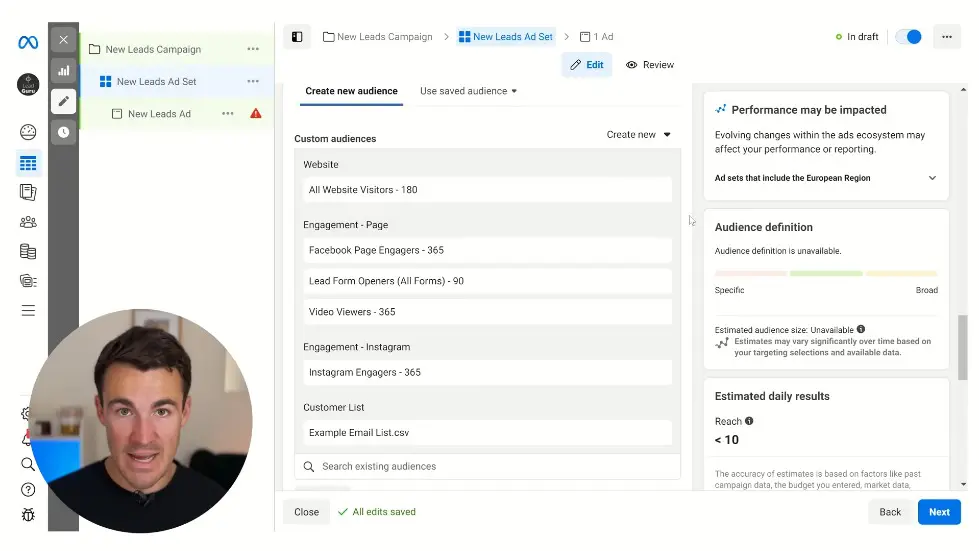
Custom Audiences and Retargeting
- Deselect "Reach people beyond your custom audience" for retargeting campaigns.
- Disable Reach people for specific scenarios where ads wouldn't make sense.
- Custom audiences decrease audience size, so keep other targeting options open.
- No need for specific interest, detail targeting, or age parameters.
- Advertise to all visitors, regardless of category, as they may influence others.

Using Custom Audiences to Create Lookalike Audiences
- Lookalike audiences are groups of people similar to another group.
- Use custom audiences to create lookalike audiences.
- Facebook analyzes the customer list and creates a list of similar people.
- Lookalike audiences perform well because they are similar to previous buyers.
- Lookalike audiences can be highly likely to buy if ads are put in front of them.
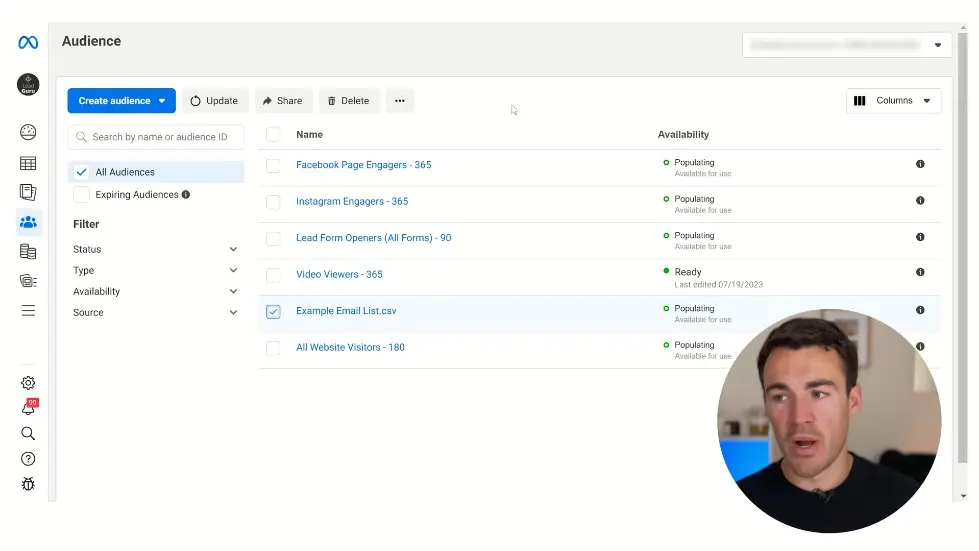
Creating a Lookalike Audience
- Lookalike audiences are best performing options for targeting Facebook ads.
- Create a lookalike audience that is similar to your email list or customer list.
- Select the source for your lookalike audience and choose from various options.
- Select the audience location, but keep in mind that you can't get too specific.
- Choose the percentage of the country's population that closely resembles your source audience.
- The larger the audience size, the better for broad targeting, but smaller audiences are more specific and accurate.
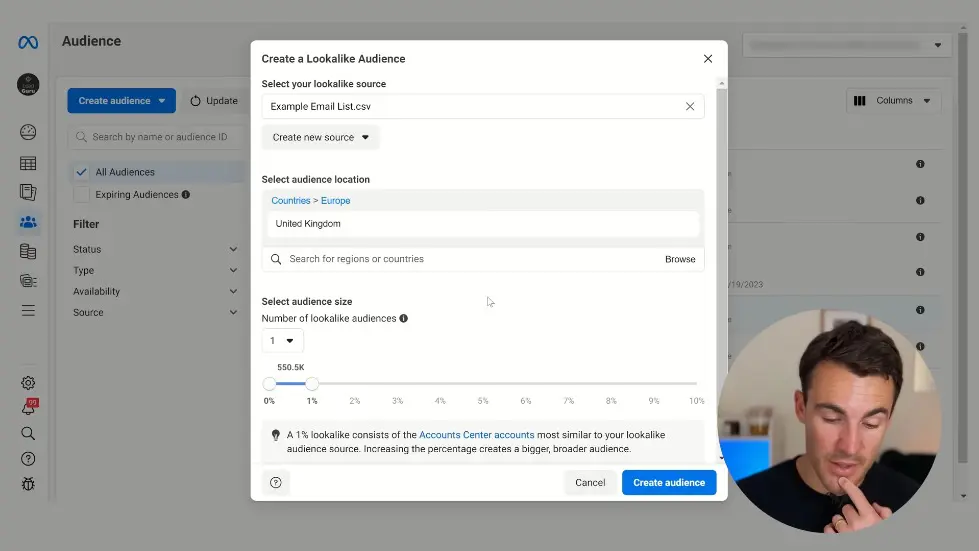
Choosing the Audience Size
- Consider the population size of the country you are targeting.
- For larger countries like the United Kingdom, a 1% lookalike audience is sufficient.
- For smaller countries like Ireland, a 10% lookalike audience may be necessary.
- For local advertising, a 10% lookalike audience is usually recommended.
- Consider the population size of the country and adjust the percentage accordingly.

Creating Lookalike Audiences Based on Different Sources
- Lookalike audiences based on customer lists are usually of better quality.
- Lookalike audiences based on engagement with your Instagram profile have larger numbers.
- Consider the trade-off between larger numbers and more specific targeting.
- If you have a small customer list, larger options may yield better results.
- Create multiple lookalike audiences and test to find the best option.

Adding Lookalike Audiences to Ad Sets
- Delete any other custom audiences or lookalikes before adding a new one.
- Consider the quality and size of the source audience when choosing a lookalike audience.
- Test different lookalike audiences to find the best performing option.
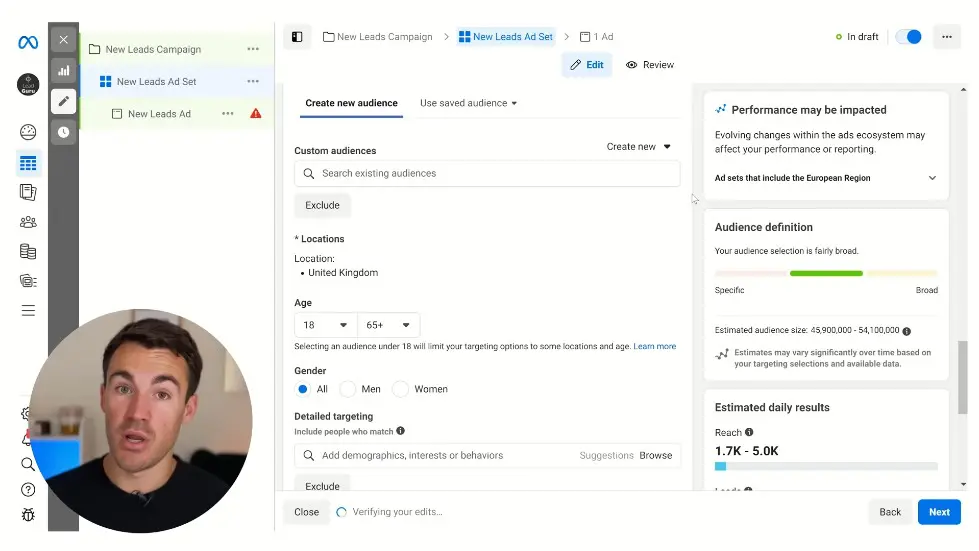
Targeting Warm Audiences
- Audience is not a warm audience, it's a cold audience.
- Create a lookalike audience based on your warm audience.
- Treat the lookalike audience as a cold audience.
- Test different ad sets for the lookalike audience.
- Do not include custom audiences and lookalike audiences in the same ad set.

Targeting with Lookalike Audiences
- Leave the targeting for age, gender, and detail open.
- Lookalike audience takes care of the specific targeting.
- Structure campaigns with multiple ad sets testing different targeting options.
- Keep the best performing ad sets running and pause underperforming ones.
- Add new ad sets to test against the best performers.
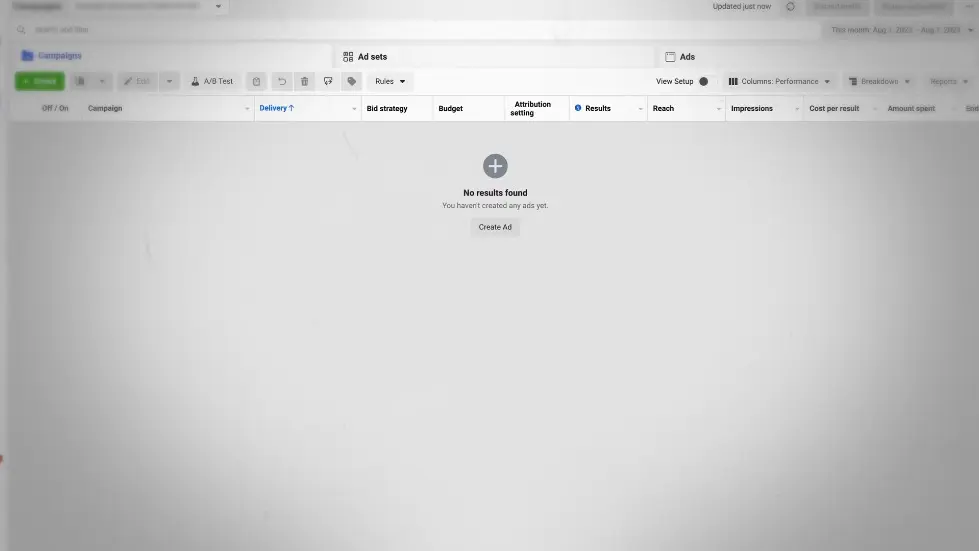
Open Targeting
- Open targeting means targeting everyone.
- Meta's algorithm determines who to advertise to.
- Open targeting works well with conversion data in the ad account.
- Open targeting may not work well for new ad accounts without conversion data.
- Open targeting is best for businesses with broad appeal.

Considerations for Open Targeting
- Products with broad appeal are more likely to succeed with open targeting.
- Niche-specific products may not perform well with open targeting.
- Consider the audience size when using open targeting for local businesses.
- Smaller cities may have limited audience size, making open targeting the best option.
- Test different targeting options to find the best performing one.
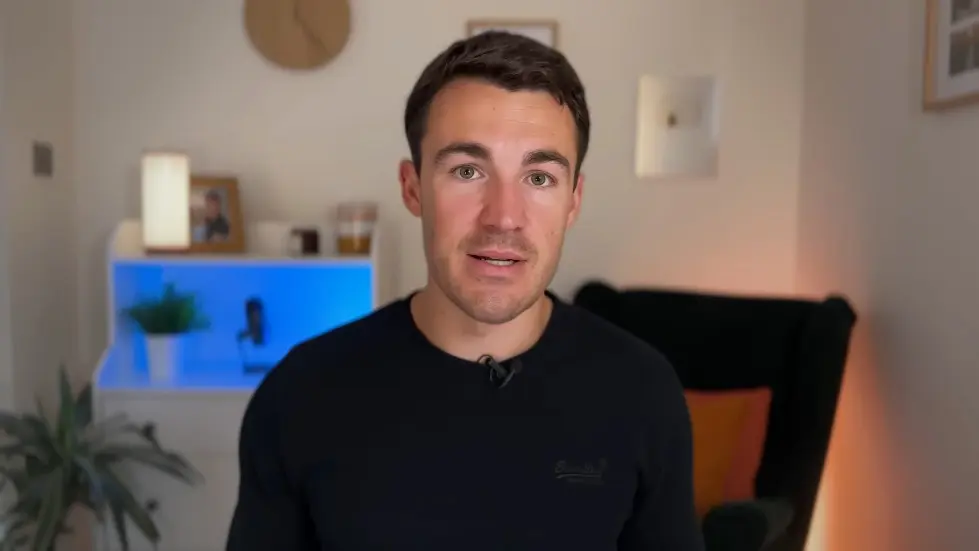
Importance of Testing and Targeting Options
- Testing different targeting options is crucial for finding what works best for each unique business.
- A poll showed that open targeting, look-alikes, and interested audiences are the three main categories with a significant spread in effectiveness.
- It is important to have a mindset of testing and finding the combinations that work for your specific business.
- Retargeting warm audiences, such as custom audiences, usually produces better results than targeting cold audiences.
- Retargeting warm audiences is a no-brainer and should be a constant strategy.
Watch the video on YouTube:
The Ultimate Facebook Ads Targeting Tutorial in 2023 - YouTube
Related summaries of videos:
- The NEW WAY To Run Facebook Ads in 2023
- Use THIS Facebook Ads Feature - I've Changed My Mind
- Facebook Ads Targeting Is Changing Forever!
- I Found An EASIER Way To Scale Facebook Ads
- Getting Leads From Facebook Just Got A LOT Easier
- Do THIS And Facebook Ads Will LOVE You!
- I Answer YOUR Facebook Ads Questions
- Advertisers are LOSING CUSTOMERS with THIS Mistake
- How To Make Money with Facebook Ads (From Scratch!)
- How To STEAL Customers From Competitors (with Facebook Ads)
